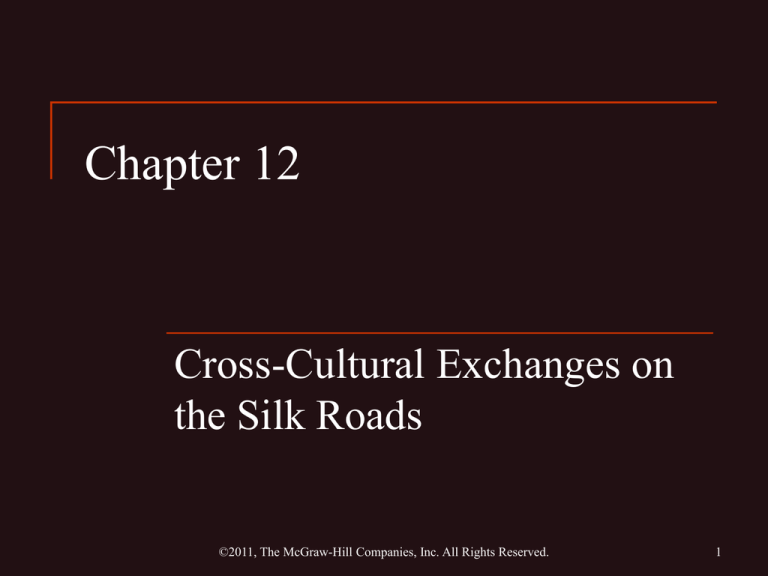
Chapter 12
Cross-Cultural Exchanges on
the Silk Roads
©2011, The McGraw-Hill Companies, Inc. All Rights Reserved.
1
Long-Distance Travel in the Ancient
World
Lack of police enforcement outside of established
settlements
Changed in classical period
Improvement of infrastructure
Development of empires
©2011, The McGraw-Hill Companies, Inc. All Rights Reserved.
Introduction
2
Trade Networks Develop
Dramatic increase in trade due to Greek
colonization
Maintenance of roads, bridges
Discovery of monsoon wind patterns
Increased tariff revenues used to maintain open
routes
Connect previously established routes i.e. China,
India, Persian “royal road”, Roman etc… plus
Indian Ocean, South China Sea, and
Mediterranean
©2011, The McGraw-Hill Companies, Inc. All Rights Reserved.
3
Trade in the Hellenistic World
Bactria/India
Persia, Egypt
Grain
Mediterranean
Spices, pepper, cosmetics, gems, pearls
Wine, oil, jewelry, art
Development of professional merchant class
©2011, The McGraw-Hill Companies, Inc. All Rights Reserved.
4
The Silk Roads
Named for principal commodity from China
Dependent on imperial stability
Overland trade routes from China to Roman
empire
Sea lanes and maritime trade as well
John Greene – Silk Road
©2011, The McGraw-Hill Companies, Inc. All Rights Reserved.
5
The Silk Roads, 200 B.C.E.-300 C.E.
©2011, The McGraw-Hill Companies, Inc. All Rights Reserved.
6
Wide variety of high value products
©2011, The McGraw-Hill Companies, Inc. All Rights Reserved.
7
Organization of Long-Distance Trade
Divided into small segments
Trade done in stages
Lighter, smaller, high value items generally traded on
land routes
Sea trade
Malay and Indian mariners
Persian, Egyptian, Greek
Bulkier cargo ie cotton, sugar, ceramics
©2011, The McGraw-Hill Companies, Inc. All Rights Reserved.
8
Cultural Trade: Buddhism and
Hinduism
Merchants carry religious ideas along silk routes
India through central Asia to east Asia
Cosmopolitan centers promote development of
monasteries to shelter traveling merchants
Buddhism becomes dominant faith of silk roads,
200 B.C.E.-1000 C.E.
©2011, The McGraw-Hill Companies, Inc. All Rights Reserved.
9
The Spread of Buddhism, Hinduism, and
Christianity, 200 B.C.E.-400 C.E.
©2011, The McGraw-Hill Companies, Inc. All Rights Reserved.
10
Buddhism in China
Originally, Buddhism restricted to foreign
merchant populations
Gradual spread to larger population, beginning
fifth century C.E.
Appealed to Chinese Daoists, traders seeking
refuge in monasteries, Chinese dissatisfied with
gov’t
Buddhism was substituted for the Daoists “way”
the new “way” becomes the Eightfold Path, daoist
temples become buddhist (syncretism)
©2011, The McGraw-Hill Companies, Inc. All Rights Reserved.
11
Buddhism and Hinduism in SE Asia
Sea lanes in Indian Ocean
First century C.E., clear Indian influence in
southeast Asia (syncretism)
Rulers called “rajas”
Sanskrit used for written communication
Buddhism, Hinduism increasingly popular faiths
©2011, The McGraw-Hill Companies, Inc. All Rights Reserved.
12
Christianity in Mediterranean Basin
Gregory the Wonderworker, central Anatolia,
third century C.E.
Christianity spreads through middle east, north
Africa, Europe
Sizeable communities as far east as India
Judaism, Zoroastrianism also practiced
©2011, The McGraw-Hill Companies, Inc. All Rights Reserved.
13
Christianity in Southwest Asia
Influence of ascetic practices from India
Desert-dwelling hermits, monastic societies
After fifth century C.E., followed Nestorius
Emphasized human nature of Jesus
©2011, The McGraw-Hill Companies, Inc. All Rights Reserved.
14
Spread of Manichaeism
Mani a devout Zoroastrian (216-272 C.E.)
Viewed himself a prophet for all humanity
Influenced by Christianity and Buddhism
Dualist (syncretism)
Good vs. evil
Light vs. dark
Spirit vs. matter
©2011, The McGraw-Hill Companies, Inc. All Rights Reserved.
15
Manichaean Society
Devout: “the elect”
Ascetic lifestyle
Celibacy, vegetarianism
Life of prayer and fasting
Laity: “hearers”
Material supporters of “the elect”
©2011, The McGraw-Hill Companies, Inc. All Rights Reserved.
16
Decline of Manichaeism
Spread through silk routes to major cities in
Roman empire
Zoroastrian opposition provokes Sasanid
persecution
Mani arrested, dies in captivity
Romans, fearing Persian influence, also persecute
©2011, The McGraw-Hill Companies, Inc. All Rights Reserved.
17
Christianity spread in Rome
Word of miracles
Dissatisfaction with Roman decay leads people to
seek new truths/options
Promise of better life (salvation)
Use of Roman symbols ie – church vestments
similar to Roman authorities, church holidays
coincide with Roman pagan feast days, church
language becomes Latin (syncretism)
©2011, The McGraw-Hill Companies, Inc. All Rights Reserved.
18
Buddhism: India
To China and S.E.A
•
The European Jesus
American Jesus
Hollywood
Jesus
African
Jesus
This is what modern day
anthropologists think Jesus looked
like.
How do images show evidence of
syncretism?
Do they affect the “appeal” of
religion?
The Spread of Epidemic Disease
Role of trade routes in spread of pathogens
Limited data, but trends in demographics
reasonably clear
Smallpox, measles, bubonic plague
Effect: economic slowdown, move to regional
self-sufficiency
©2011, The McGraw-Hill Companies, Inc. All Rights Reserved.
22
Epidemics in the Han and Roman
Empires
©2011, The McGraw-Hill Companies, Inc. All Rights Reserved.
23
Internal Decay of the Han State
Court intrigue
Problem of land distribution
Large landholders develop private armies
Epidemics
Peasant rebellions
184 C.E., Yellow Turban uprising
©2011, The McGraw-Hill Companies, Inc. All Rights Reserved.
24
Collapse of the Han Dynasty
Generals assume
authority, reduce emperor
to puppet figure
Alliance with landowners
200 C.E., Han dynasty
abolished, replaced by
three kingdoms
Immigration of northern
nomads increases
©2011, The McGraw-Hill Companies, Inc. All Rights Reserved.
25
Nomadic Invasions of Han China
China’s greatest threats came from the
Xiongnu nomadic empire. They are also
known as the Eastern Huns.
©2011, The McGraw-Hill Companies, Inc. All Rights Reserved.
26
Sinicization of Nomadic Peoples
Sinicization = Social and cultural changes to a
Chinese way of life
Adapted to the Chinese environment
Agriculture
Adoption of Chinese names, dress, intermarriage
©2011, The McGraw-Hill Companies, Inc. All Rights Reserved.
27
Popularity of Buddhism and Daoism
Disintegration of political order casts doubt on
Confucian doctrines
Buddhism, Daoism gain popularity
Religions of salvation
©2011, The McGraw-Hill Companies, Inc. All Rights Reserved.
28
Fall of the Roman Empire:
Internal Factors
The “barracks emperors”
235-284 C.E., twenty-six claimants to the throne,
all but one killed in power struggles
Epidemics
Disintegration of imperial economy in favor of
local and regional self-sufficient economies
©2011, The McGraw-Hill Companies, Inc. All Rights Reserved.
29
Diocletian (r. 284-305 C.E.)
Divided empire into two administrative districts
Co-emperors, dual lieutenants
“Tetrarchs”
Currency, budget reform
Relative stability disappears after Diocletian's
death, civil war follows
Constantine emerges victorious
©2011, The McGraw-Hill Companies, Inc. All Rights Reserved.
30
Fall of the Roman Empire:
External Factors
Visigoths, influenced by Roman law, Christianity
Formerly buffer states for Roman empire
Attacked by Huns under Attila in fifth century
C.E.
Massive migration of Germanic peoples into
Roman empire
Sacked Rome in 410 C.E., established Germanic
emperor in 476 C.E.
©2011, The McGraw-Hill Companies, Inc. All Rights Reserved.
31
Germanic Invasions and the Fall of the
Western Roman Empire, 450-476 C.E.
©2011, The McGraw-Hill Companies, Inc. All Rights Reserved.
32
Cultural Change in the Roman
Empire
Growth of Christianity
Constantine’s vision, 312 C.E.
Promulgates Edict of Milan, allows Christian practice
Converts to Christianity
380 C.E., Emperor Theodosius proclaims
Christianity official religion of Roman empire
©2011, The McGraw-Hill Companies, Inc. All Rights Reserved.
33
St. Augustine (354-430 C.E.)
Hippo, north Africa
Experimented with Greek thought, Manichaeism
387 C.E., converts to Christianity
Major theologian
©2011, The McGraw-Hill Companies, Inc. All Rights Reserved.
34
The Institutional Church
Conflicts over doctrine and practice in early
Church
Divinity of Jesus
Role of women
Church hierarchy established
Patriarchs, bishop of Rome
The following video is edgy and controversial. It is intended to be a demonstration of
syncretic forces at work in all religions not as an attack on religion.
©2011, The McGraw-Hill Companies, Inc. All Rights Reserved.
35









